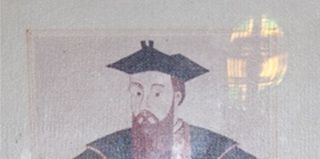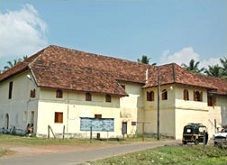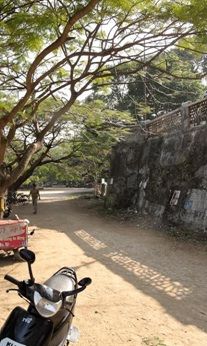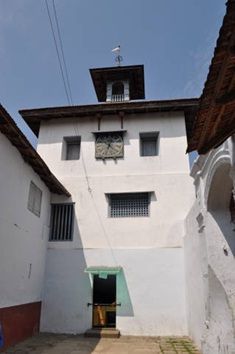Article
Mattancherry Palace: Almost a UNESCO Heritage Site
Author(s):
The town of Cochin, India is home to not only the Mattancherry Palace, which is on the wait list to become a UNESCO Heritage Site, but also the Paradesi Synagogue.
There are several surprising things about the Mattancherry Palace. One is that it isn’t a UNESCO Heritage site yet because it’s just on the “wait” list. The other is that it costs so little to enter — just five rupees. At 54 rupees to the dollar, that means the admission is about 10 cents.
Compare that one-tenth of a dollar to the ticket price for an American museum; for example, the Neue Gallery at 86th Street and 5th Avenue in NYC. It displays early twentieth-century German and Austrian art and design. The entrance there is $20 — 200 times as much as the Mattancherry Palace. And, I might add the Neue is not on the wait list to become a UNESCO Heritage site either.

Vasco da Gamma, the Portuguese explorer, arrived in 1502 in Cochin, where he died in 1524. Notice the reflection of a cross in the right hand corner of the photo. It embodies the religious fervor the Portuguese brought with them to India that resulted in the equivalent of an inquisition. Photo courtesy of Shirley M. Mueller
.
The Mattancherry Palace is simple on the outside and opulent on the inside. Photos are not allowed inside, which is why none are shown here.
It was built by the Portuguese in 1545 CE in Portuguese and Oriental style, not for themselves but for the local ruler, Veera Kerala Varma. In doing this, the occupying traders were trying to make amends for destroying a local temple that they considered pagan. This was their way of currying favor with the local population so their import-export business could continue without major disruption in spite of their offenses.

The outside of the Mattancherry Palace. Photo copyright Bharatonline.com.
The story of Cochin, also known as Kochi, is one of commerce. Before the Portuguese arrived in 1500, the area was used by the Greeks, Romans, Jews, Arabs and Chinese to trade spices. When the nearby harbor of Kodungallur, 15 miles to the Northwest, was destroyed by flooding in 1341, Cochin became the main port for exchange. This made it valuable.
The Dutch took notice and in 1683 seized the Portuguese outpost. It was then that they made renovations to the Mattancherry Palace, which is also known today as the Dutch Palace. At the same time, the original fort that the Portuguese had built was extended further by the Dutch.

Remains of the Fort originally built by the Portuguese and expanded by the Dutch are still present in Cochin (to the right). Photo courtesy of Shirley M. Mueller
It was not until 1814 that the Dutch gave up the area to the British by signing the Anglo-Dutch treaty. Finally, in 1947, India was able to wrestle free from its last European occupier: Britain. Cochin was the first native state to join the Indian Union willingly.

The clock tower of the Paradesi Synagogue in Cochin; photos are not allowed in the Synagogue. Photo courtesy of
.
The international flavor of Cochin is reflected in the Paradesi Synagogue. Though it was built in 1568 for the recent arrivals — the Paradesi or white Jews of Cochin — Judaism had been present in Cochin much longer. It is believed that after the destruction of the great temple in Jerusalem in 70 CE that Jews escaped to Kodungallur near Cochin. They established the oldest Jewish community in India known as the Black or Malabar Jews.
The Portuguese, in their religious fervor, were not tolerant of the Jews or any religion other than their own. This fanaticism improved markedly when the Dutch took over Cochin as they practiced religious tolerance. Today only a small number of Jews remain in the area.

The Chinese fishing nets are still used in Cochin today; in fact the fish can be seen jumping in the net. This location is near the old Portuguese-Dutch Fort. Photo courtesy of Thomas Mueller
.
Some specifics:
There are very nice accommodations in the immediate area. It is possible to walk from some of them to all of the sites mentioned above. An easier way would be to hire a driver with an air conditioned car for a day plus a guide. This could be done at the hotel. When I did it, the cost was $125 for six hours.
How to get there:
: Walking is easy and flat. Wear sunscreen and a hat for ultraviolet ray protection when going between buildings. On a different note, when buying merchandise, inspect it carefully. I bought a shirt that looked great superficially, but when I scrutinized it at home, found that it had torn threads, which makes it much less desirable.
Caution
These attractions take only about half day. But, there is so much more to do in the area that staying two to three days in Cochin would be worthwhile and interesting.
Read about the rest of Shirley Mueller's India trip:
Mumbai: Gateway to South India
Elephanta Island, India: A UNESCO Heritage Site
Old Goa: a UNESCO Heritage Site
Total Time:
Another ancient practice that still takes place in Cochin is net fishing, said to be introduced by merchants from the court of Kublai Khan. The giant nets are dropped in the water and when filled with fish lifted up so the catch can be retrieved. Oddly, today these nets are found only in Cochin, not in China.Cochin is a welcoming, interesting and unhurried town. It is the best of leisure combined with mental stimulation. There are few who would not enjoy a visit.




